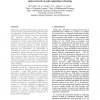Free Online Productivity Tools
i2Speak
i2Symbol
i2OCR
iTex2Img
iWeb2Print
iWeb2Shot
i2Type
iPdf2Split
iPdf2Merge
i2Bopomofo
i2Arabic
i2Style
i2Image
i2PDF
iLatex2Rtf
Sci2ools
IPPS
2007
IEEE
2007
IEEE
RNAVLab: A unified environment for computational RNA structure analysis based on grid computing technology
Ribonucleic acid (RNA) molecules play important roles in many biological processes including gene expression and regulation. An RNA molecule is a linear polymer which folds back on itself to form a three dimensional (3D) functional structure. While experimental determination of precise 3D RNA structures is a time consuming and costly process, useful insight into the molecule can be gained from knowing its secondary structure. Structural elements in RNA secondary structures can be separated into two large categories: stem-loops and pseudoknots. The development of mathematical models and computational prediction algorithms for simple stem-loop structures started early in the 1980’s. However, building systems that provide the tremendous computer time and memory needed for RNA analysis of both stem-loops and pseudoknots remains a challenge even today. The recently developed grid computing technology can offer a possible solution to this challenge. In this paper we briefly address mathem...
Distributed And Parallel Computing | IPPS 2007 | RNA Molecule | Rna Structure | Secondary Structures |
| Added | 03 Jun 2010 |
| Updated | 03 Jun 2010 |
| Type | Conference |
| Year | 2007 |
| Where | IPPS |
| Authors | Michela Taufer, Ming-Ying Leung, Kyle L. Johnson, Abel Licon |
Comments (0)

